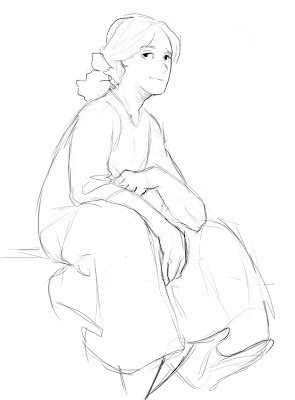Q: What constitutes masculinity and femininity in the world of the story?
A: In the context of this piece, the distinction of masculinity and femininity is largely defined by biological functions, as in, women menstruate and bear children and men don't have to worry about that.
The central conflict in this piece, between the cyclist and the rest of the women, seem to argue more about whether they should or shouldn't be defined by the biological differences between the sexes.
The majority of the women agree that menstruation is a handicap that was used by the patriarchal society to explain away why women shouldn't be equal in power and authority (citing that the biological function makes a woman irrational).
The cyclist however believes that menstruation is a symbol of womanhood, to her one of the most important aspects of her feminine identity.
In some ways the author shows that while the future is pushing to redefine what is possible and acceptable for women, the tradition models of masculinity and femininity will persist. Some of it because it is our history, and some because there are still biological differences between the sexes. Even if you put a stop to menstruation the very ritual of stopping that biological difference would provide an experience for women that is different than men and that will play at least some part in shaping their female identity.
But of course, women are becoming more recognized as creatures who aren't quite so limited as they were previously defined, and this story seems a little bit of celebration in that idea.
Monday, February 27, 2017
Monday, February 20, 2017
Samia - The Lady Hero
If I were to create a female heroine her name would be Samia. She has dim brown hair, cut at shoulder length and tied back into a lazy tail. Her facial features have a droopy quality to them which makes all her smiles look a little insincere.
Samia is a sort of wandering trickster character, largely defined by her power to travel instantaneously through an organic medium. It's like teleportation but it requires her to touch part of a biological body (ex. a root of a tree) and she can only teleport to anywhere else the same biological body reaches to (ex. just above one of the tree's branches).
Other people and organic things can be taken with her when she performs her teleportation, but Samia cannot take anything else such as metal. Because she lives in a time period before paper money, Samia ends up losing her money all too easily and as a result often resorts to relying on other people's goodwill to be fed, clothed, and sheltered in the duration of her travels.
Throughout her journeys in unfamiliar lands, Samia becomes exposed to the intimate problems that affect the people she imposes upon. Some issues can be solved with her intervention but many of them cannot. Samia herself is largely a simple-minded character, getting caught up in helping whichever party she comes across first without question. She's an honest woman in her dealings, but acts to hastily which sometimes leads to more harm than good.
The entire theme of her story would be one of the interplaying mechanics between control and helplessness; between independence and dependence. It's a battle strongly tied to gender, but it isn't necessarily restricted to it.
Samia's role as a woman and a wanderer is questioned and prodded at, her lifestyle is not always seen as welcome in the societies she travels to, but there is a sense of envy among many of them; after all, Samia can be virtually untouchable if she so desires, which is a freedom so few can enjoy (especially for the women). While Samia's strange power can be a means for heroics, it also distances her ability to connect to people on a social level, which continues to reinforce her wandering ways.
Subscribe to:
Comments (Atom)
